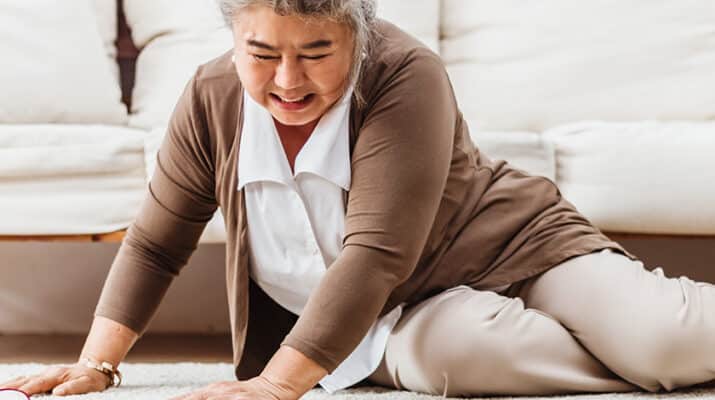Experts provide tips on how not to be part of this group
By Deborah Jeanne Sergeant

According to the Centers for Disease Control and Prevention, 28% of Americans 65-plus will fall this year.
The National Institutes of health reports “Falls in older adults are a common occurrence and may lead to serious injuries (like head injury and fractures). Recurrent falls are also frequent and are responsible for significant morbidity and mortality in older adults.”
The consequences of falling are great for people who cannot rise and lie on the floor injured for hours or even days. What often happens after a fall and serious injury is that older adults remain less active because they’re recovering from the fall. Or they choose to reduce their activity level because they fear another fall injury.
Reducing activity level also leads to greater dependence upon others for activities of daily living. Ideally, preventing falls is better than trying to introduce fall reduction measures after a fall has occurred.
Environmental factors can make a big difference in preventing falls.
“The big one we see are patients who live in older homes with the washer and dryer in the basement and steep steps, which are especially hazardous if carrying a laundry basket,” said physician Sharon Brangman, chairwoman of geriatric medicine, director of the geriatric medicine fellowship program and director of the Upstate Center of Excellence for Alzheimer’s Disease at SUNY Upstate Medical University.
She wants patients to have their washer and dryer moved up to the first floor, if possible. It’s also important to keep stairs in good repair and eliminate carpets or runners on stairs.
“You also want them well-lit at night and have handrails,” Brangman said.
She added that household spills and clutter can also contribute to falls.
“Keep the floor dry and pick up things that are a trip hazard,” she said. “If your feet stick, that’s a trip hazard. Be careful about sneakers with thick treads and cushion. It can change your perception of where your foot is. Some people don’t lift their foot as high while walking as they get older. Sometimes thinner soled shoes are better for walking. Avoid heels. Make sure that the soles are rubber, so they have some traction.”
Shoes with medium to high heels, open backs and ill fit can often contribute to falls.
When Mike Ritter, director of Rehabilitation for PACE CNY of Loretto, assesses a living space for falls, he looks for throw rugs and poor condition carpeting.
“Does it fold up on the edges?” he said. “Some carpets are old and worn and have flipped up on the edge over time. That may mean removing area rugs or using tape on the edges to hold them down.”
Bath rugs should be non-skid and hung up once no longer in use. Grab bars in the bathroom and maybe along a long hallway can also help, but one doesn’t need to “put grab bars anywhere,” but rather use “strategic placement of grab bars,” Ritter said.
Typically, near steps, the tub or shower and near the toilet are the key places. A floor-to-ceiling transfer pole can help getting in and out of bed. A transfer bench can also help people bathe more easily.
“They can sit first and then swing their legs in,” Ritter said. “Once you’re in, you can stand up to clean properly, using the grab bar in the tub. It can be useful and helpful for that.”
Handrails at home entrances and grab bars — not the suction cup kind — near the tub and toilet can also reduce falls. These should be installed by a pro and sturdy enough to support an adult’s weight. Towel bars are not enough.
Most people require more lighting to see well as they grow older. To help mitigate this effect, Ritter recommends contrasting duct tape on steps and sufficient lighting over staircases. Motion sensing lights can illuminate the pathway to the light switch. For homes with insufficient outlets, battery-operated and solar lights can help.
The raised threshold between rooms or uneven flooring on a patio or porch can cause falls, as can stairs, since people don’t perceive the difference in height. Contrasting tape on steps to make these transitions easier to see.
Along with changes in vision, many people experience changes in balance as they age. For this reason, medication that was fine before may now dramatically increase risk for falling.
Kristine Cervantes, doctor of physical therapy and professor of practice in the department of occupational therapy at Purcell School of Professional Studies at Le Moyne College, wants older adults to ask their healthcare provider about their medication, including “psychotropic medications — antidepressants, antianxiety, mood stabilizers,” she said.
Another commonly overlooked aspect of fall prevention is assistive devices. Ironically, a cane or walker can contribute to falls if it’s not the right device, adjusted correctly or maintained.
“An occupational or physical therapist can properly prescribe and size as well as teach proper use of any assistive device,” Cervantes said.
Patients in New York do not need a prescription or referral from a doctor to see a physical therapist for 10 visits or 30 days. A physical therapist can help with assistive devices, provide fall risk assessment and help patients reduce fall risk through exercise.
Cervantes recommends that people stay active to prevent falls, as this helps maintain muscle mass, bone strength, agility and balance.
“Choose an activity or exercise or a few that you enjoy and incorporate into a daily routine and stick with it,” she said. “Continue to challenge yourself with new or different activities. Incorporate balance and strength exercises. Try yoga or tai chi, which has been shown to very effective at reducing falls.”
Many older adults reduce their activity level because they fear falling. Instead, Cervantes recommends creating a plan in case of a fall, including practicing how to get up off the floor and having a friend or neighbor check in regularly. Using devices can also summon help more quickly.
“Emergency response systems are very common,” Cervantes said. “They are activated by pushing a button on a wearable device such as a necklace or wristband and are directly connected to 911 services. However, there is a fee. Carrying a cell phone is another option, but with smart devices ever so common, setting up a voice activated call system like Alexa is an excellent and reliable option to either call family, friends or emergency services.
“Smartwatches can even be set up to make emergency calls at the push of a button and others can even detect sudden fall-like movements and automatically call for help. These smartwatches also have fitness tracking capability with free apps that can help people choose and stay motivated with activities and exercise,” Cervantes said.
She also said some free apps can help with fall assessment, like HCPA StopFalls, Senior Safety Quick Fall Screen.

